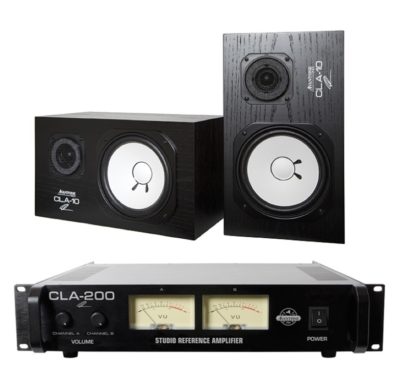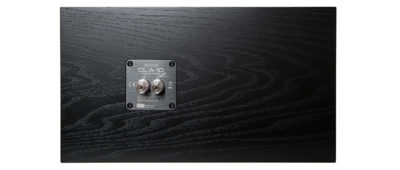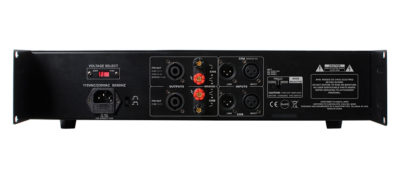New Gear Review: CLA-10 Monitors & CLA-200 Power Amp by Avantone Pro

With the release of the CLA-10 speakers and CLA-200 power amp, Avantone Pro & Chris Lord-Alge aim to bring the authentic NS-10 experience to users far and wide.
Avantone Pro has been manufacturing professional studio equipment for the last decade-plus. They offer an intriguing lineup of products, some of which border on “reissues” and others that are newly-conceived products.
With everything from “drum mics in a box” style kits to recreations of classic large diaphragm tube and condenser mics, Avantone’s reach extends to various corners of the market.
Two of their most notable products until now—at least to me—have been in the world of monitoring. There’s the Mix-Cubes, their single-woofer studio monitors that pay homage to the studio classic Auratones, and the indispensible Mix-Phones MP-1 Headphones—a pair I have found to be a true game-changer in the professional engineer headphone category.
Now, with the introduction of the CLA-10 nearfield monitor and CLA-200 power amplifier combination, Avantone Pro partners with legendary mixer Chris Lord-Alge to take direct aim at recreating the professional studio classic Yamaha NS-10M setup. Let’s take a closer look and see what it’s all about.
Features
The CLA-10 is a two-way nearfield studio monitor. The cabinet is made of MDF with a wood veneer and the dimensions are modeled after the original NS-10, with each cabinet weighing in at 13.9 lbs. The speaker boasts a frequency response of 60Hz to 20,000Hz with a power rating of 60 watts for program material, and 120 watts max.
The low frequency driver here is the Avantone AV10-MLF, and the high frequency driver is the AV10-MHF tweeter. The speaker features classic binding post inputs, and all components are made in house by Avantone with strict quality control standards, allowing pairs to be matched practically identically.
The CLA-200 is a rack-mountable class AB studio reference power amplifier custom made to drive these speakers optimally. It has a near ruler-flat frequency response of 20Hz to 20,000Hz with a variance of +/- 0.5 dB, less than 0.05% THD, and signal to noise ratio of >94dB.
Power is rated at 200W at 8 ohms, 300W at 4 ohms, or bridged 500W at 8 ohms. It’s sized to fit into a rack taking up 2RU spaces, comes with feet for operation outside of a rack, and it weighs in at 44 lbs. The amp features XLR inputs along with binding post and speakon outputs, and is convection cooled so there’s no fans adding noise to your workspace.
In Use
There is no pair of studio monitors more iconic—and yet polarizing—than the NS-10s. In the first recording studio I ever set foot in as teenager, there was a pair of NS-10s sitting on the console meter-bridge, and to this day (nearly 30 years later) every pro studio either has a pair of NS-10s on the desk, or have a pair handy. There’s a reason for that.
Love ‘em or hate ‘em, when a mix sounds good on a pair of NS-10s it will typically translate to many other systems. Meaning, if your mix works on NS-10s in the studio environment, it’ll likely work in a wide variety of other environments like the car, living room, club, bar, stadium, earbuds… you name it.
I happen to love NS-10s. I love them because I know them well to be a faithful companion. They’re not easy to get along with as they make you work to have a healthy relationship with them. They’re not easily pleased in that generally if a mix is not “together” it will fall apart on NS-10s. So when I found out that Avantone was releasing a new version of the NS-10M Studio (my preferred model of NS-10), I was skeptical they’d make a faithful recreation of the original—shortcomings included.
The originals are high maintenance and not really cut out for the casual user. To make an analogy, the original NS-10’s are not your Black and Decker drill with the padded handle you use to tighten loose screws or to put kids’ toys together—they’re the Milwaukee drill you use when you’re doing serious work.![]()
I was thrilled to unbox my CLA-10s and the CLA-200 power amp. They are nearly identical to a pair of NS-10Ms; while my NS-10Ms have a smooth matte finish, the CLAs have a slightly shinier appearance, and show a very slight wood grain. The CLAs felt sturdier than my NS-10Ms, most likely because I got mine used nearly 2 decades ago, have logged some serious hours of work on them, and have done quite a bit of traveling with them.
The sheer heft of the CLA-200 took me by surprise; this is no lightweight power amp. The amp is a key component here as anyone who works on powered speakers will tell you the amp makes a tremendous difference in the way the speakers sound and perform. I made quick work of swapping out my Bryston 4B for the CLA-200, and set up the CLA-10s in place of my NS-10M Studios.
Upon first listen, I was very surprised to hear they did indeed sound like a pair of NS-10Ms with brand new components. I know this because it’s common to replace the NS-10M components regularly, sometimes at the start of mixing a serious project after they’ve been used on the daily grind for awhile.
Avantone smartly suggests letting the speakers burn in for a period of time (about 72 hours), and I get it—just like that brand new hinge or cushion with new springs, it takes a bit of time for the mechanics of the woofer to loosen up. After being sufficiently broken in, the speakers will then perform consistently for the majority of their lifespan until they’re ready to be replaced. But for me, it’s not uncommon to blow a woofer or tweeter in the middle of a session with the original NS-10M, so I’m used to getting straight to work on brand new components. So I did.
The first order of business was just listening to music on them; I compared the CLAs to APS Aeons. I consider the APS to be a darker speaker, and the CLAs were indeed a bit brighter, as I would expect an NS-10 to be. After about an hour of listening to reference mixes of current projects, previous mixes from streaming services, and some songs/mixes I know and love, I was beginning to believe Avantone actually made a brand new NS-10M.
Still skeptical, I swapped out one CLA for one of my worn NS-10Ms. To even out playback volume, I made a slight adjustment on the front panel knob of the CLA-200 (a nice touch having front panel knobs instead of cal trims like the Bryston, or worse—knobs on the rear like some other power amps). I have to admit I was shocked; they sounded like a matched pair of speakers—old meets new, and they were working together just fine.
Now I set out to get to work on them. It was a day of working tirelessly on lead vocal tracking with new artist Deon Arcade. I’ll be honest, I had grown tired of my worn NS-10Ms as of late, and had been using my ProAc Studio 100s more often (which are now on the endangered species list due to component procurement). While I like using the ProAcs as a complement to the NS-10s for mixing, they’re not always the best choice for tracking.
I immediately felt very comfortable using the CLA-10 and NS-10M combination. It was easy to fine tune the high-pass filter to just the right point, address the lower frequencies of the vocal to prevent boomy-ness, and get the vocal to cut through the music track nicely while recording. The slight brightness associated with NS-10s was clearly part of the CLA sound as well, which made it easy to fine tune the de-esser. It was a joy to listen quietly while tracking and still hear the details I needed to hear in order to get the vocal to sit just right. After a day of tracking and mixing, I found my rough mix was in great shape, so it took minimal work to finalize the day’s reference mix. So far so good.
Next up was a day of mix tweaks for Kahme.wav, with the initial mixes having taken place on the ProAcs. I got rid of the worn NS-10M and set the CLA-200 amp for the CLA pair quite easily. I immediately was able to hone in on some high frequency issues with the vocals that weren’t so apparent on the ProAcs; the CLAs made it easy to dial in just the right amout of brightness and de-essing. Again, nailing the high-pass filter setting was cake with the CLAs.
Also, I have learned to listen loud on NS-10Ms while mixing. Not to say I don’t listen quietly as well, but, when a mix is right, NS-10s can take the high SPLs. In addition, anyone used to NS-10s will tell you that by visually looking at the woofer, you can get an idea if your bottom end is right. When you see just the right amount of speaker excursion at these high SPLs, you know your bottom is probably in good shape.
Putting too much lows through an NS-10 will make the woofers “curl,” “bottom out,” and crackle—the same here with the CLAs. I was shocked to see the woofers on the CLAs behaving exactly as I would expect on a pair of NS-10s. For modern speakers that are geared towards home studios, I quite often feel translatability is sacrificed for components that will not easily blow, but this is not the case with the CLA-10s.
Now came mix tweaks for Cadie Cruz. This time I had the CLAs, ProAcs, and APS with a KRK Sub going—truly a trinity of mixing monitors. The APS with KRK sub gave me the impression of very large studio monitors. The ProAcs were a bit on the bit darker side with a little more bottom than what you’d expect from an NS-10, and the CLAs served as the magnifying glass to help identify issues throughout the frequency range—be it using my ears or eyes. At this point, I was sold and never wanted to look back to using my old worn NS-10Ms again. As a matter of fact, a friend was giving me a studio tour of his brand new facility, and when I saw his NS-10Ms sitting on the desk, they looked like old news to me.
My last project reviewing the CLAs was with Venus Rose; we spent a day and a half tracking and editing vocals. Once again, the CLAs were a pleasure to work on, providing much detail to the vocal range while tracking, and performing well at all playback volumes, whether tracking or reference mixing. They also made matching some newly recorded material to previous rough mixes a snap.
To Be Critical
All in all, I am super impressed with the work done by Avantone Pro to recreate every detail of the speaker I know and love. I can’t find any real criticism of the CLA-10 nearfield or CLA-200 power amp. They are purpose-built, and Avantone completely hit the mark here.
The CLA-10s really are a brand new pair of NS-10Ms, yet modernized with a great new look and upgraded connectors. The build quality is top-notch, the components give the impression of those found in brand new NS-10Ms, and the new finish makes them look great on top of my console. The CLA-200 amp is clear, powerful, transparent, noise-free, and built for the job.
Summing it Up
I highly recommend the Avantone Pro CLA-10s and CLA-200 to anyone looking to replace their NS-10s or to enhance their workflow. The speakers provide a near-exact replication of the sought-after NS-10 sound that today’s engineers still crave, and the amp is crystal-clear with power to spare. I also would strongly recommend anyone looking to replace their existing NS-10 components with Avatone’s AV10-MLF and AV10-MHF, as they seem to be an exact match.
At $699 for a pair of CLA-10s, and $799 for the CLA-200, Avantone Pro is providing a more cost effective entryway or replacement plan to the NS-10 workflow than was ever available before. I urge anyone looking to get better mixes to invest in the combo of CLA-10s and CLA-200… but remember, this playback rig will make you work for your sound, and not just any mix will translate. If you put in the work, your recordings and mixes will become more polished, more defined, translate better to other systems, and generally sound more professional. Well done Avantone on making the new classic.
Paul J. Falcone is a veteran recording engineer and mixer who lives in New York. Check him out on Instagram at @pjfmusic, @theresidencestudios, and @theprofoolspodcast, and on twitter at @pauljfalcone.
Please note: When you buy products through links on this page, we may earn an affiliate commission.








